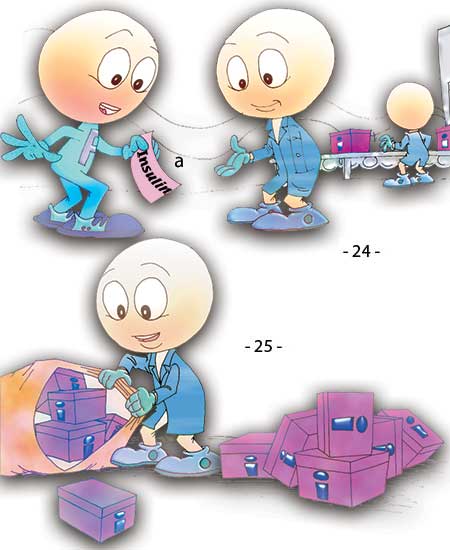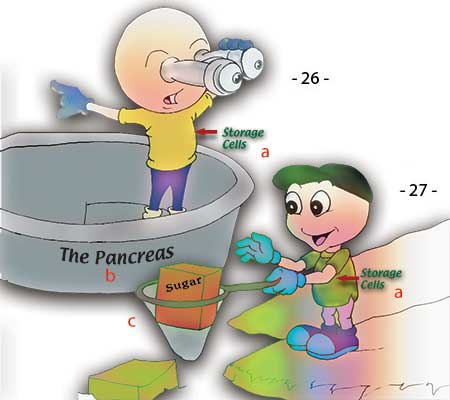5. The Sugar Factory
If you eat more sweets than you need, then an exceedingly detailed and flawless system in your body goes into action to prevent your blood-sugar level from rising:
1- First, the pancreas cells detect sugar molecules from among the millions of molecules in the blood and separate them from the others. Moreover, they decide whether there are too many of these molecules or too few, literally counting their number. How can invisibly small cells without eyes or a brain possess criteria for the proper level of sugar molecules in the blood? That's a matter requiring reflection. (Figure 23).
2- If the pancreas cells determine that there's more sugar in the blood than needed, they move to store this surplus sugar. However, they do not perform this storage themselves, but order it to be carried out by other cells at a considerable distance away.
 |
| a. The pankreas |
| Figure 23: Pancreas cells are able to distinguish sugar molecules from among the millions of other molecules in the blood. Moreover, they literally count the sugar molecules, and decide whether there are too many of them, or too few. |
3- These distant cells do not normally store sugar until they receive a command to do so—when the pancreatic cells emit a hormone that instructs them to begin storing sugar. The formula for this hormone, known as insulin, has been recorded in their DNA since the instant when pancreas cells first came into existence (Figure 24).
4- Special enzymes (or "worker proteins") in the pancreatic cells decipher this formula and produce insulin in line with its instructions. Hundreds of enzymes, each with different jobs, work together in its production.
5- The insulin produced is sent to the target cells by way of the blood, the body's most reliable and fastest transportation network. Some of these target cells lie in the liver.
 |
a. insulin |
| Figure 24: Pancreas cells send a hormone telling the relevant cells to start storing sugar. This hormone is known as insulin. Figure 25: The insulin hormone is produced by special enzymes in the pancreas cells and reaches the liver and other relevant organs via the bloodstream. |
6- The liver cells receive the insulin's command to store sugar and obey unconditionally. Chemical "gates" that permit the sugar molecules to enter the cells are opened (Figure 25).
7- However, these gates do not open at random. The storage cells in the liver distinguish only sugar molecules from among hundreds of different molecules in the bloodstream, and then catch and imprison them inside themselves (Figures 26 and 27).
8- The liver cells never disobey a command reaching them. They never misinterpret that command, or trap the wrong substances, or store excessive sugar. They work with enormous discipline and self-sacrifice. Therefore, when you drink a cup of tea with too much sugar in it, this extraordinary system goes into action and stores the surplus sugar in your liver. If this system did not function properly, then your blood-sugar levels would rise rapidly and you would enter a diabetic coma, commonly resulting in death.
 |
a. Storage cell |
| Figures 26 and 27: Storage cells in the pancreas can distinguish sugar molecules from among all the millions of molecules in the blood, and stores as many as they require. |
9- This is such a perfect system that it can also work in the opposite direction when necessary. If the sugar in your blood falls below normal levels, the pancreas cells produce another hormone, known as glucagons, which tells the cells that were formerly storing sugar to release it. The cells obey this command, and release the sugar they had stored (Figure 28).
How can cells with no brains, nervous systems, eyes or ears flawlessly come up with such complex calculations and functions? How can these unconscious assemblages of protein and fat molecules perform tasks that are beyond the capability of educated human beings? What is the source of this awareness exhibited by unconscious molecules? Of course, these events are just a few of the countless proofs of the existence and might of God, Lord of the universe and of all living things.
In verses God states:
God—Him from Whom nothing is hidden, either on earth or in heaven. It is He Who forms you in the womb however He wills. There is no deity but Him, the Almighty, the All-Wise. (Surah Al 'Imran, 5-6)
 |
| a. Release sugar into the bloodstream |
| Figure 28: Glucagon carries an instruction for the cells that previously have been storing sugar to release it into the bloodstream. The cells obey this command and release the sugar they have stored into the blood. |
- Introduction
- 1. Monitors That Control the Level of Fluids in the Blood
- 2. The Body's Impeccable Security System
- 3. Mother's Milk and the Hormone Oxytosin
- 4. Calcium Measurers
- 5. The Sugar Factory
- 6. Emergency Assistance The Hormone Adrenaline
- 7. The Lysosomal Enzymes That Purify the Body
- 8. The Flowless System That Regulates Blood Pressure
- 9. Growth Hormone
- 10. The Clock in Our Bodies That Never Goes Wrong
- 11. The Miraculous Molecule That Regulates Body Temperature
- 12. An Extraordinarily Delicate Balance
- 13. Hormones That Prepare the Way For the Baby -1
- 14. Hormones That Prepare the Way For the Baby -2
- 15. The Hormones in the Male Reproductive System
- 16. Other Properties of the Hormone Testosterone
- 17. Hemoglobin: The Miraculous Oxygen – Bearing Molecule
- 18. The Communications System in the Cell
- 19. The Messenger Hormone's Journey within the Cell
- 20. Communication Control in the Cell
- 21. Protein Traffic within the Cell
- 22. Chemical Communication in the Nerve Cell
- 23. Nitric Oxide: A Skilled Messenger
- 24. The Endothelial Cell: A Nitric Oxide Production Center
- 25. The Power Station in the Human Body
- 26. The
- 27. DNA Replication
- 28. Repair Enzymes
- 29. Protein Production
- 30. The Final Stage of Protein Production
- 31. The Cell Membrane and 100 Trillion Organized Workers
- 32. What Happens at the Moment of Hearing?
- 33. Blood Clotting
- 34. The Immune System
- 35. The Journey of Vitamin B12
- 36. The Pancreas: The Human Body's Chemist
- 37. Transporter Molecules in the Cell Membrane
- 37. Complement Proteins Responsible for Protecting the Body
- 39. Anti – Acid Formulas Producing Molecules
- 40. The Consciousness Displayed by Egg Cells
- Conclusion
